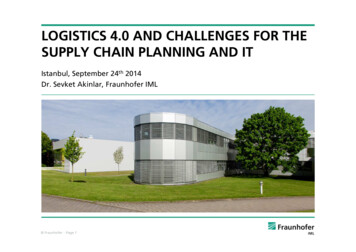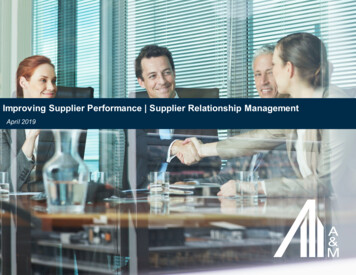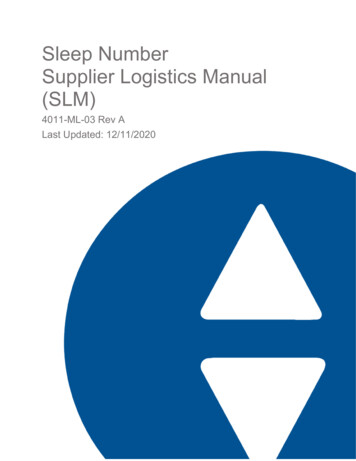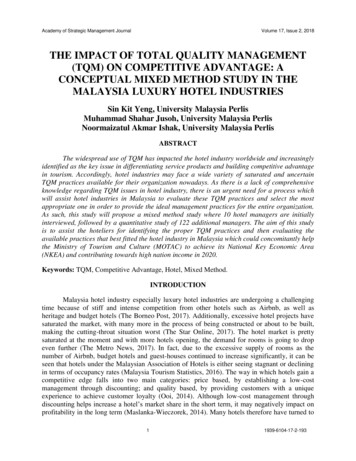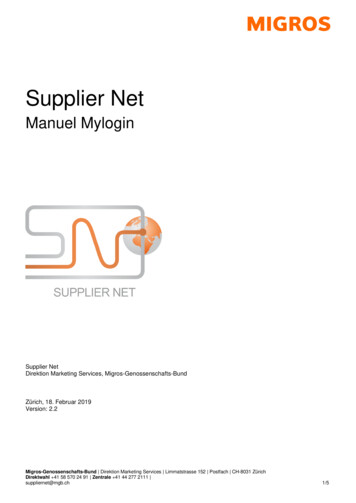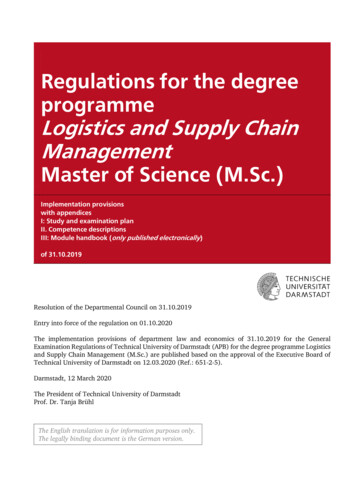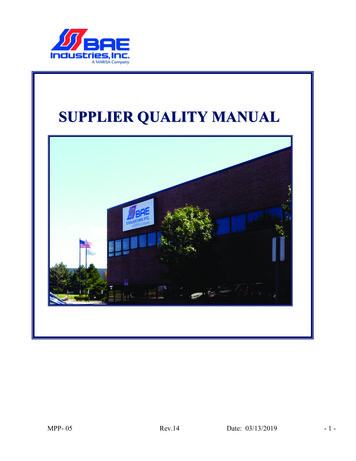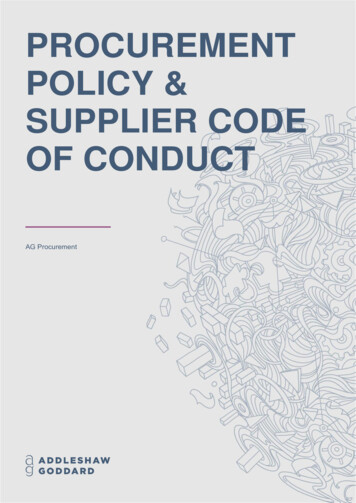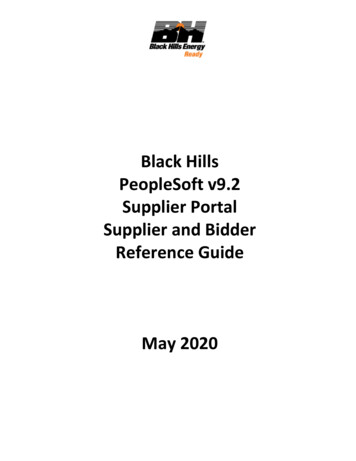
Transcription
Logistics Supplier manual Version 2.01 50LOGISTICS SUPPLIER MANUALVersion 2.0ContentsPreface6Supplier manual Scope61 Information management in logistics61.1 SUPPLIER - SEG communication . 61.1.1Contact61.1.2Availability61.2 Information transmission . 71.2.1Business processes with EDI71.2.2EDI link options72 Control concepts and order processing82.1 Control concepts . 82.1.1VMI82.1.2Call-off PO92.1.3Consignment92.2 Flexibility and release periods . 92.2.1Production and material releases2.2.2Minimum order quantities102.2.3Flexibility102.2.4Start-up and phase-out control10Reference: SG/LOG Printed in Germany June, 20189SG/LOG
Logistics Supplier manual Version 2.03 Packaging2 50113.1 Packaging specifications . 113.1.1Packaging design criteria113.1.2Responsibilities and definition of packaging specification113.1.3Permitted and non-permitted materials123.1.4Delivery specifications133.1.5Requirements for electrostatic discharge (abbr.: ESD) protection153.1.6Corrosion prevention and moisture control163.1.7Packaging for hazardous goods163.2 One-way packaging . fic requirements depending on transportation type163.3 Returnable packaging . 193.3.1Specification depending on type of returnable packaging193.3.2Empties management213.3.3Provision and storage of SEG returnable empties213.3.4Repairs and scrapping213.3.5Cleaning223.3.6Labeling of SEG returnable packaging by the SUPPLIER233.3.7SEG standards for returnable SLC233.3.8Adapter pallets and roller carriages234 Transport logistics234.1 Basic information on shipping from SUPPLIER to SEG . 234.1.1Transportation companies, couriers, and package shipments234.1.2Packages and HUs254.2 Shipping and transportation documents . 254.2.1Shipping documents254.2.2Transport documents264.3 Labeling of products . 284.4 Transport notification . 314.4.1Transports not processed through BOSCH TMC314.4.2Transports processed through BOSCH TMC314.4.3Special arrangements for transportation of critical goods314.5 Label for sample parts . 32Reference: SG/LOG Printed in Germany June, 2018SG/LOG
Logistics Supplier manual Version 2.03 504.6 ASN . 324.7 Shipping process . 324.8 Security in goods transportation . 325 Special transports and variation management335.1 Special transports . 335.2 Variation management . 335.3 Risk and crisis management in logistics . 345.3.1Background345.3.2Definition, tasks, and objectives346 Logistics quality356.1 Definition . 356.2 SUPPLIER Result Assessment (abbr.: LEB) – Logistics . 356.3 Logistics complaints . 356.4 Controlling of logistics performance by SUPPLIER . 367 Further developments in logistics368 Index of abbreviations379 Definition of terms3910 Appendices4010.1 Appendix 1: Delivery matrix: Central requirements for cooperation in logistics . 4010.2 Appendix 2: Transport Order (TO) . 42Reference: SG/LOG Printed in Germany June, 2018SG/LOG
Logistics Supplier manual Version 2.04 5010.3 Appendix 3: Label . 4310.3.1Introduction4310.3.2Labeling standards in compliance with VDA 4902/ODETTE4410.4 Appendix 4: Technical agreement on specifications of the EDI-connection . 47Reference: SG/LOG Printed in Germany June, 2018SG/LOG
Logistics Supplier manual Version 2.05 50Index of FiguresFigure 1: Permitted and non-permitted materials .12-13Figure 2: Series B1 for deliveries without external carton . 18Figure 3: Series B3 for deliveries without external carton . 18Figure 4: Cleaning Responsibility by region. 22Figure 5: Example roller carriage type 600x400mm . 23Figure 6: Example adapter pallet . 23Figure 7: Regional standards for shipping documents . 25Figure 8: Format and attachment of product tags . 28Figure 9: Index of abbreviations .37-38Figure 10: Definition of terms . 39Figure 11: Standard delivery concepts . 40Figure 12: Standard delivery concepts continued . 41Figure 13: Example of TO . 42Figure 14: Main product label for original packaging (pallet, pallet cage) / The content of the label is shown as an example. 44Figure 15: Secondary labels for secondary packaging (SLC, carton . ) / The content of the label is shown as an example. 45Figure 16: Binding and optional fields . 46Reference: SG/LOG Printed in Germany June, 2018SG/LOG
Logistics Supplier manual Version 2.06 50PrefaceCompetition in national and international markets has intensified significantly in recent years. Increased customerexpectations in terms of quality and flexibility mean that our company and the entire supply chain is faced with increasinglydemanding challenges.Traditional logistics has turned into an integrated, customer-focused management function, which is increasingly a strategicsuccess factor in our company's competitiveness. The companies in the SEG Group depend on cooperation with reliable,expert, and customer-focused SUPPLIERs.Supplier manual ScopeThis Supplier manual sets out the conditions for delivery of products by the SUPPLIER (as defined in Chapter 9). The rulesit contains are applicable as a supplement to the agreements made with the SUPPLIER relating to the delivery of products(e.g. EZRS corporate agreement, A-SUPPLIER agreement, multi-year contract, (price) agreements, orders; the “deliverycontract”).All companies of the SEG Group (all companies directly or indirectly controlled by SEG Automotive Germany GmbH ("SEG")are entitled to apply the regulations set out in this Supplier manual in its SUPPLIER logistics processes with the SUPPLIER,or its respectively responsible group companies (companies affiliated to SUPPLIER pursuant to § 15 AktG), from whomthey purchase products.The SUPPLIER is responsible for the quality of their products and for compliance with the requirements and rules set out inthis Supplier manual.Deviations from or additions to this Supplier manual (e.g. to take into account special requirements for the SEG plant supplied(as explained in Chapter 9) can be agreed upon in writing (as defined in Chapter 9) between the SUPPLIER and SEG.1 Information management in logisticsConstructive cooperation between the SUPPLIER and SEG requires targeted communication.The key elements of this are: Prompt and unsolicited information in case of changes to any circumstances relating to the supply relationships. Compliance with and monitoring of agreements made. Use of state of the art communication methods.1.1SUPPLIER - SEG communication1.1.1 ContactThe SUPPLIER and SEG name responsible contact persons. The SUPPLIER will also name a deputy and line manager, ineach case specifying the name, position, e-mail address, telephone number, and mobile phone number, along with anemergency telephone number (the "emergency telephone").The communication language is either the language of the SEG plant supplied or English.1.1.2 AvailabilityThe contact designated by the SUPPLIER (or their deputy) must be available on working days (as defined in Chapter 9)during normal local working hours (at least from 8:00 to 16:00 - local time for the SUPPLIER in each case) and iscommunicated to the SEG contact (as defined in Chapter 9).Outside normal local working hours, the SUPPLIER must be available using the emergency telephone during the productionhours of the SEG plant supplied. The emergency contact reached using the emergency telephone must be authorized tomake decisions on production and shipping (particularly the organization of special transports).Reference: SG/LOG Printed in Germany June, 2018SG/LOG
Logistics Supplier manual Version 2.01.27 50Information transmissionTarget is an integrated data system between SEG and the SUPPLIER, with no manual interfaces (media breaks).Therefore, transmission of information via Electronic Data Interchange (abbr.: EDI) is a prerequisite for a supply relationshipwith SEG. The SUPPLIER shall use EDI to receive information from SEG and to send information to SEG. If the SUPPLIERhas no existing EDI link to SEG, a schedule for introduction of EDI needs to be agreed and implemented by the SUPPLIER.The technical requirements and approved message formats are determined by standards used in automotive market. SEGuses temporarily BOSCH-Server for EDI-transmissions. For further information, see BOSCH EDI brochure www.ediservice.bosch.com1.2.1 Business processes with EDIThe following business processes, in particular - where they are used - are to be carried out with EDI support: Transmission of the call offs (as defined in Chapter 9) from SEG to the SUPPLIER. Transmission of the advanced shipping notification (abbr.: ASN) from SUPPLIER to SEG. KANBAN call offs. Transmission of vendor managed inventory (abbr.: VMI) information. For consignment warehouse processing: self-billing invoice (abbr.: SBI) (if legally permitted, country-specific) and stockmovement list (inventory report message). Transmission of confirmed dates/quantities from SUPPLIER to SEG. Empties management1.2.2 EDI link optionsOne of the two types of EDI link described below is to be used:Classic EDIClassic EDI includes a specific IT infrastructure on the SUPPLIER and customer side for processing electronic messageformats. Classic EDI is designed to support direct communication between Enterprise Resource Planning (abbr.: ERP)systems with no media break, i.e. the information is exchanged between the SUPPLIER and customer side informationprocessing systems with no additional manual recording. When using classic EDI, the consistency of the system (ensuringcorrect and complete data transfer) must be guaranteed for the entire planning, production, and shipping process by theSUPPLIER.WebEDI (actually SupplyOn)With WebEDI, information is exchanged between the SUPPLIER and customer via an Internet platform. Information isexchanged between the SUPPLIER and SEG via the SupplyOn Internet platform (available at http://www.supplyon.com).When using WebEDI, the SupplyOn server processes the EDI data transmitted by SEG as web forms and provides them tothe SUPPLIER along with message forms for data recording. To operate the system, the SUPPLIER requires a computerwith Internet access.The SUPPLIER can use SupplyOn to create the shipping documents. Information on labeling of the products from the calloff is to be transferred to the shipping documents.Technical detailsTechnical details for both types of EDI needs to be mutually defined as of Appendix 4Reference: SG/LOG Printed in Germany June, 2018SG/LOG
Logistics Supplier manual Version 2.08 502 Control concepts and order processingThis chapter sets out the requirements for receipt and processing of call-offs, and the scheduling of SEG requirements in theSUPPLIER's production and delivery schedules.SEG will notify the SUPPLIER of requirements according to the control concept used by SEG. These notifications will partlybe issued as non-binding forecast requirements (preview) and partly as production and material releases.Based on this the SUPPLIER will ensure that: Their sub-SUPPLIERs deliver the appropriate primary material Their production capacity is sufficient for the notified preview, and Deliveries are made to SEG on time2.1Control conceptsSEG aims to make the entire supply chain from the SUPPLIER to SEG as lean and low-waste as possible.In procurement, a distinction is made between the following control concepts:1. VMI (preferred)2. Call-off purchase orders (abbr.: PO)) Reorder point pull (abbr.: ROP pull)Variation: Standard daily call-off based on forecast delivery scheduleMoreover, transfer of ownership should take place as late as possible:3. ConsignmentSee details on the control concepts in this chapter 2 and in annex 1. The SUPPLIER implements the requirements of therespective control concept. These are based on economic perspectives. If market conditions do not permit the implementationof individual requirements, an additional agreement is to be drawn up in consultation with the affected SEG plant logistics.Independently of control concept, goods may be shipped to SEG plant- to line (STL) - preferred- to supermarket- to warehouse2.1.1 VMIVMI is preferred control concept. SUPPLIER sets up VMI on request of SEG Plants.When using VMI, the traditional two-way material requirements planning for the flow of products from the SUPPLIER to SEG(SUPPLIER: order planning, SEG: customer planning) is replaced by a single material requirements planning. TheSUPPLIER holds the inventories within the stipulated minimum and maximum inventory levels by acting in a proactive andanticipatory manner and taking into account transport times and delivery windows. SUPPLIER material requirementsplanning is based on the information on inventories and the predicted requirements from SEG, which SEG regularlycommunicates to the SUPPLIER.The VMI Monitor (e.g. of SupplyOn) is main tool and enables the SUPPLIER and SEG to have the same view of relevantVMI information at all times.SEG provides the information on inventories, stock movements, and gross requirements (as defined in Chapter 9) (the "VMIinformation") on a daily basis. The SUPPLIER receives the VMI information from SEG and is independently responsible forholding inventories between the stipulated lower and upper inventory limits. The data in the VMI Monitor is definitiveSUPPLIER gets call-offs in addition to fill his MRP-System easily with data. Call-offs show production and material releasesfor products controlled using VMIIf requested by SEG, the SUPPLIER must notify SEG with information on the planned deliveries: Also, for each delivery, theSUPPLIER sends an ASN to the SEG plant supplied (see section 1.2.1).Reference: SG/LOG Printed in Germany June, 2018SG/LOG
Logistics Supplier manual Version 2.09 50The arrangements in the SEG VMI manual (The Internet-adresse refering on this document is changed currently. You will beinformed about the final Internet-adresse seperatly. In case of need you have the possibility to get the most actual versionfrom your purchasing contact or your responsible contact person within plant logistics department.) are applicable.2.1.2 Call-off POCall-offs are communicated on a rolling basis. They are updated regularly and contain order and master data (e.g. quantitiesand dates) with a horizon of several months. Master data relevant for call-offs must be communicated by the SUPPLIER(e.g. value added tax identification number (abbr.: VATIN.)). The last call-off is relevant and supersedes previous call-offs.In exceptional cases, PO are transmitted by agreement (e.g. orders for samples, operating supplies (abbr.: HIBE), machineaccessories and replacement parts (abbr.: MAZE).Order processing and trackingThe delivery dates specified in the call-off or PO are binding dates for receipt of the goods in the SEG plant supplied. TheSUPPLIER ensures delivery on the incoming date by determining the correct shipping date from the SUPPLIER taking intoaccount transportation times and the applicable Incoterm (as defined in Chapter 9). Different arrangements can be made(e.g. dates specified in the call-off match the shipping date (dispatch date) (See Chapter 7). The SUPPLIER checks theincoming order for completeness, accuracy, and plausibility (e.g. SUPPLIER name, part number, quantity, date) and notifiesSEG immediately of any discrepancies. The SUPPLIER operates a continuous internal order tracking system. TheSUPPLIER is able to provide information about production progress at any time. The SUPPLIER ensures that subSUPPLIERs operate a transparent order tracking system.2.1.3 ConsignmentConsignment is preferred method of transfer of ownership – and to be used whenever allowed by local law withoutadditional physical effort in supply chain.When using consignment, the SUPPLIER remains the legal and economic owner of the consignment goods until they arewithdrawn from the consignment warehouse. The consignment warehouse can be located at SEG or at a logistics serviceprovider (abbr.: LSP) engaged by SEG. Warehouse management is carried out by SEG or a LSP engaged by SEG.Unless otherwise agreed, transportation of the products to the consignment warehouse is arranged by SEG.Consignment needs to be set up correctly following local tax law: a contract is needed between respective units of SUPPLIERand SEG.The SUPPLIER must comply with the tax obligations resulting from operation of the consignment warehouse (e.g. valueadded tax (abbr.: VAT) registration) under the applicable legislation and provide SEG with the necessary information.Control of consignment warehouse is included in consignment contract. If legally allowed, Self Billing Invoice (SBI) will beused. On request of SUPPLIER, SEG provides daily/weekly stock information.2.2Flexibility and release periods2.2.1 Production and material releasesPeriods for production and material releases can be set out in the call-off or the delivery contract, for example. For call-offs,periods mentioned in the production and material releases start with the date of the call-off. For VMI, they start with thetransmission time of the VMI information. If the market situation requires, the release periods can be temporarily shortenedor extended by SEG. If the issued releases are demonstrably insufficient to maintain delivery capability, SEG can extend therelease period at the request of the SUPPLIER. All changes to production / material releases must be made in writing.Reference: SG/LOG Printed in Germany June, 2018SG/LOG
Logistics Supplier manual Version 2.010 50Required quantities beyond the production and material release periods are non-binding planned figures (preview), whichthe SUPPLIER uses as a basis for their production capacity.The production and material releases are governed by the terms of the delivery contract. Unless agreed otherwise, thefollowing shall apply:Subject to alternative agreements, SEG can move the delivery date for each call-off with no penalty. SEG may also terminatecall-offs. In the event of termination, SEG only has to pay compensation if no appropriate replacement call-offs were granted.The compensation is limited upon selection by SEG to (a) the acceptance and payment or (b) the adoption of scrapping costsfor contract products or material for which a binding production release or material release was issued. For the scrappingcosts, the purchase prices of the SUPPLIER are crucial. The compensation requires proof from the SUPPLIER that theycannot otherwise use the finished products or the material and cannot cancel material purchase orders. For semi-finishedcontract products, SEG only has to take on the proportional costs according to the production status or the proportionalscrapping costs. The SUPPLIER is required to minimize the costs as far as possible in the event of a termination.2.2.2 Minimum order quantitiesMinimum order quantities are not permitted unless SEG agrees to a minimum order quantity in exceptional situations.Where possible, SEG orders quantities optimized in terms of logistics costs wherever possible and works on the basis ofoverall cost optimization and total cost of ownership (abbr.: TCO), taking into account costs incurred by both SEG and theSUPPLIER. The quantities can be less than a full handling unit (abbr.: HU) / packing unit.If it is economically necessary for the SUPPLIER to produce a certain quantity, the SUPPLIER informs SEG of this. If this isaccepted by SEG, this can also be reflected as a production release by SEG upon request from the SUPPLIER. From oneproduction batch several SEG plants may be supplied.2.2.3 FlexibilitySEG will take into account transport times and, where possible, order in such a way that additional costs to both partiesresulting from the order are avoided. If additional costs resulting from the order are unavoidable, they will be borne by SEGor the SUPPLIER according to who is responsible for those costs being incurred (causation principle).Additional costs to the SUPPLIER resulting from the order may not be claimed if SEG moves the delivery date for an orderthat has not yet left the SUPPLIER plant.Flexibility (in terms of the delivery contract regarding individual contracts, call-offs and capacity reserve) is subject to theterms of the delivery contract. Unless otherwise agreed in the delivery contract:Unless otherwise agreed, call-off s are deemed respectively accepted by the SUPPLIER if the SUPPLIER does not objectto them in writing within two (2) working days of receipt. An objection to the call-off by the SUPPLIER shall only be allowedin case the legally binding order (production release) exceeds the previous non-binding preview from SEG by more than 20percent. For an agreed multi-year contract (abbr.: MYC), a capacity reserve of (up to) 33 percent must be implemented forits duration, based on the preview transferred by SEG and the underlying shift model. This capacity reserve serves to bufferpeak requirements and must therefore be implemented in the short term without additional costs and process changes bythe SUPPLIER.2.2.4 Start-up and phase-out controlSEG expects increased flexibility from the SUPPLIER in the start-up and phase-out phases. The start-up and phase-outquantities and dates must be agreed between SEG and the SUPPLIER in good time. The control concept is to be discussedand, if necessary, adapted based on the requirements of the individual situation.Reference: SG/LOG Printed in Germany June, 2018SG/LOG
Logistics Supplier manual Version 2.011 503 Packaging3.1Packaging specifications3.1.1 Packaging design criteriaThe packaging between SEG and the SUPPLIER is to be designed based on economic, quality, and environmental criteria.In terms of economic criteria, the packaging may not be of higher value than is absolutely necessary to safeguard the qualityand integrity of the products during transportation to, storage and production at SEG. It must be ensured that the packagingemployees or other persons are protected from hazards caused by the products themselves (e.g. hazardous goods). Thepackaging itself may not cause any hazard for persons (e.g. protruding nails). From an environmental perspective, recyclableand unmixed materials are to be used, which are environmentally compatible and easy to dispose of, and are labeled incompliance with the disposal business specifications.Further requirements for packaging: Easy handling during opening and closing, and for repacking operations. Stackable loading units: dynamic stacking factor (as defined in Chapter 9) at least 2 (1 1). Optimum filling of packages and loading units to optimize transport costs Gross weight per loading unit (as defined in Chapter 9) maximum 1,000 kg.In justified exceptional cases, a special approval can be agreed in consultation with the SEG contact. The gross weight per manually handled package (as defined in Chapter 9) is normally between 10 and 15 kg: alternativeagreements can be made for specific requirements or due to regional regulations. For loading units with basic dimensions 1200x800 mm, the following preferred external dimensions apply for packages:300x200 mm, 400x300 mm, or 600x400 mm. (See section 3.2 and section 3.3.) Loading units may not have any protruding or jutting labels or strips; in particular cartons must be dimensionally stableand have correctly folded covers. Mixed pallets are generally permitted. They must be clearly labeled as mixed pallets. Posting and unmixed storage mustbe possible with no additional costs (for example stackable (intermediate) load carriers). The use of mixed pallets mustbe agreed with the SEG contact. (See section 3.1.4 and section 4.1.2). International symbols should be used to label goods that are subject to special handling. Specific requirements of relevant delivery plants regarding packaging to be coordinated together with delivery plant.Those are mandatory for packaging design. Specific requirements apply for the North American Free Trade Agreement (abbr.: NAFTA) in accordance with the NASUPPLIER Packaging & Labeling StandardsThe Internet-adresse refering on this document is changed currently. You will be informed about the final Internetadresse seperatly. In case of need you have the possibility to get the most actual version from your purchasing contactor your responsible contact person within plant logistics department.3.1.2 Responsibilities and definition of packaging specificationThe packaging is to be defined at an early stage - if possible during the development phase - in agreement between the SEGplant supplied and SUPPLIER. SEG standard or standardized packaging (e.g. German Association of the AutomotiveIndustry (Verband der Automobilindustrie; abbr.: VDA) is preferred.Before release of the packaging by SEG, the SUPPLIER needs to adequately test the packagin
Transmission of the advanced shipping notification (abbr.: ASN) from SUPPLIER to SEG. KANBAN call offs. Transmission of vendor managed inventory (abbr.: VMI) information. For consignment warehouse processing: self-billing invoice (abbr.: SBI) (if legally permitted, country-specific) and stock movement list (inventory report message).
